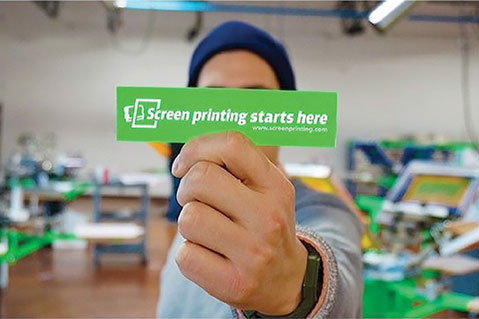Strategy June 14, 2016
How to Screen Print Signs or Stickers
Garments aren’t the only substrates that can be screen printed – so expand your printing horizons.

1. Start with solvent-based air-dry ink. This type of ink dries naturally over time and doesn’t require curing. For that reason, it’s the ideal ink for printing signs or stickers, which may react unfavorably to heat. Keep in mind this type of ink does require time to dry, so printing multiple colors will require time between printings, and setting up the print of each color separately.
2. Place your stencil. Take the film positive and place it where you want the print to land. Line the image up with the stencil on the screen. The positive can be seen through the screen, so line it up until the stencil on the screen is in the right place. Tape the substrate to be printed on the press base using masking tape (a 4-inch piece on each side should be adequate).
3. Create bump guides. Bump guides will ensure that when the material is moved in to meet them, the print will land in the same location on every piece. The guides will need to be about 2 inches long and 1 inch wide. A total of three will be needed. Use scrap substrate, cardboard or scrap wood to create the guides. Make sure the guide isn’t taller than the substrate to be printed. Place one guide on the left side, 5 inches up from the bottom of the substrate to be printed, and touching the substrate. Place another about 3 ½ inches from the bottom left corner. Place the third guide along the bottom, about 10 inches from the left bottom guide. Securely tape all the guides to the base of the platen.
4. Flood-coat your screen. Mix your inks and position your first substrate using the bump guides. Flood-coat the screen by pulling the ink across the screen with very little pressure while the screen is in the up position. Lower the screen and push or pull the squeegee across the piece being printed, using enough pressure to clean the image area of ink. Immediately reflood the screen with ink to prevent the stencil from drying out.
5. Remove the substrate. Establish a drying area; remember that substrates will be wet when removed from the press, so they shouldn’t be stacked on top of each other.
Print Additional Colors
Once the substrate is printed with the first color, remove the bump guides and place the new screen into the press. This time, register the design to one of the already-printed substrates and completely dried. Create new bump guides as specified above; then print the additional color. Each color must dry before additional colors are printed. Make sure screens and squeegees are cleaned after printing one color is completed and before printing the next color.
Watch This!
There are lots of items besides garments that can be screen printed. This video from Ryonet Corp. shows how to print stickers, glass, metal signs and more. View the video here:
